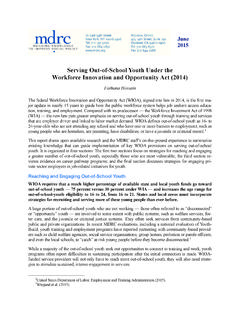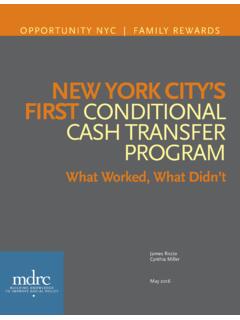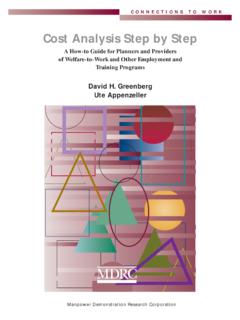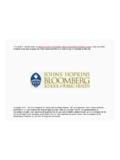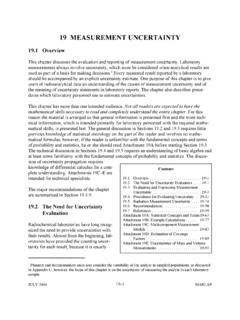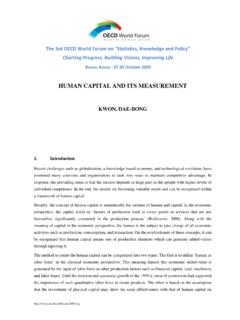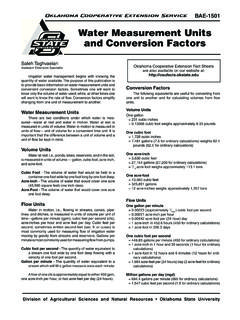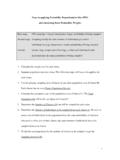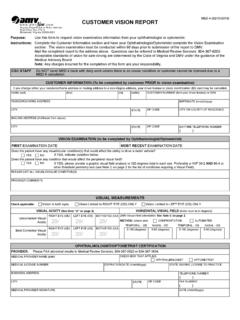Transcription of Design Options for Home Visiting Evaluation - MDRC
1 Design Options for home Visiting Evaluation home VISIT OBSERVATION BRIEF. Overview of Observational measurement Instruments Available for home Visiting September 2012. Introduction Formal observational assessments of home visits, for supervisory or evaluative purposes, can be a key component in achieving effective program implementation and improved participant outcomes for home Visiting programs. Specifically, home visit observations can be used to evaluate the content and quality of activities that occur during the home visit, the quality of the provider-client relationship, and the level of family engagement in services. This focus on assessment and feedback on the quality of services can help inform home Visiting practice, guide overall program improvement, and inform continuous quality improvement (CQI).
2 Efforts. The intent of this document is to support the Maternal, Infant, and Early Childhood home Visiting (MIECHV) program as part of the provision of technical assistance (TA) to funded grantees. Specifically, this brief provides an overview of available home visit observation instruments for assessing home visit quality and content for use in reflective supervision practices, professional development, research Evaluation , or CQI. These suggestions are intended to be a helpful tool; there is no federal requirement to observe home visits. Selection of Instruments for Inclusion in this Brief1. In compiling the list of instruments for this brief, the DOHVE TA team conducted a review of existing observational measures used for supervision, quality assurance, and evaluative research within the realm of home Visiting programs for families with young children.
3 Specifically, the team systematically examined relevant literature and participated in conversations with both home Visiting model and instrument developers to obtain published and unpublished information about each instrument. These search strategies resulted in a list of six relevant and available observation instruments: (1) home Visit Rating Scales1 (HOVRS); (2) home Visit Rating Scales Adapted (HOVRS-A)2; (3) home Visit Characteristics and Content Form3; (4) home Visit Observation Form4; (5) home Visit Assessment Instrument5 and (6) Supportive Interactions with Families: A. Self Rating In reviewing and summarizing home Visiting observation instruments, we focused on the following components: instrument items, rating scales, scoring mechanisms, psychometrics (reliability and validity), and constructs measured.
4 1. Neither HHS nor DOHVE endorse the use of these instruments. Inclusion of an instrument in this brief, as stated above, was based on a review of the existing literature and was intended to be inclusive of all relevant measures. 1. home Visit Observation measurement Instruments 1. home Visit Rating Scales (HOVRS). The HOVRS was developed to describe and evaluate strategies used in home Visiting interventions. Specifically, the HOVRS measures the home visitor's effectiveness in engaging the parent and the child in home Visiting activities and in interactions with each other. The HOVRS is a field-derived measure that has been used in research settings.
5 It can be adapted to include additional indicators that relate to specific program goals and local cultures/communities. Use and Scoring The HOVRS can be used in live or video-recorded observation. Its seven items can be combined to form a total score and two subscale scores: (1) home Visitor Strategies Quality (Facilitation of Parent-Child Interaction; Relationship with Family, Responsiveness to Family, Non-Intrusiveness) and (2) Effectiveness Quality (Parent-Child Interaction during home visit, Parent Engagement during home visit, Child Engagement during home visit). Each of the seven items is scored on a scale of one to seven with anchor points: 1 (inadequate), 3.
6 (adequate), 5 (good), and 7 (excellent). The items also include descriptive observable examples at the anchor points to inform ratings. Psychometric Properties Reliability7: Acceptable internal consistency of the overall quality HOVRS score (alpha = ). Acceptable inter-rater reliability of total HOVRS score (>.85%, Kappa > .75). Validity8: The authors assessed predictive validity at the family level by correlating the Strategies Quality scores with the home Observation Measure of the Environment ( home ) (beta = .29, p < .05) and Peabody Picture Vocabulary Test (PPVT)/Child Language (beta = .30, p < .05). 2. home Visit Rating Scales Adapted (HOVRS-A).
7 The HOVRS-A is a home visit instrument adapted from the original HOVRS. It can be used both for Evaluation and for formative purposes ( , reflective supervision) and the scale items can be adapted to align with the home Visiting program curriculum and pre-determined standards for home visitor Use and Scoring The HOVRS-A consists of the same seven items as the HOVRS that can be combined to form a total score and two subscale scores: (1) home Visitor Strategies Quality (Facilitation of Parent-Child Interaction; Relationship with Family, Responsiveness to Family, Non- Intrusiveness) and (2) Effectiveness Quality (Parent-Child Interaction during home visit, Parent Engagement during home visit, Child Engagement During home Visit).
8 However, the HOVRS-A differs from the HOVRS in three ways. First, the seven HOVRS-A items are scored from one to five instead of one to seven and have three anchor points at one (inadequate), three (adequate), and five (good). Similar to the HOVRS, the HOVRS-A also includes lists of 2. indicators under each of the three anchors to assist observers in determining an appropriate rating. Second, the indicators are aligned across each of the three anchor points (1, 3, and 5). to ensure consistency in the HOVRS-A. Third, two scale items (the home Visitor Relationship with Family item and the Child Engagement During home Visit item) are slightly Psychometric Properties Reliability:11.
9 Good internal consistency of total HOVRS-A score (alpha = ). Acceptable internal consistency of the home visitor strategies score (alpha = ). Excellent internal consistency of the participant engagement score (alpha = ). Validity: Concurrent and Predictive validity could not be determined due to small sample size. 3. home Visit Characteristics and Content Form The home Visit Characteristics and Content Form is designed to document specific concrete characteristics of observed home visits, such as the length of the visit, the participants involved, and the language in which the visit was conducted in. This instrument was developed to supplement the HOVRS and/or HOVRS-A, but can also be used alone or in conjunction with other home visit observation instruments.
10 Use and Scoring The Characteristics and Content form documents the activities conducted during the home visit ( , problem solving, crisis intervention, provision of emotional support to parent, observation of caregiver-child interactions, etc.), the percentage of time allocated for various activities ( , child-focused activities, parent/family-focused activities, crisis management activities, etc.), the extent to which specific topics were covered ( , child health and development, parenting, parent health and well-being, employment/education, community services), and other relevant information about visit ( , number of adults and children who participated).
